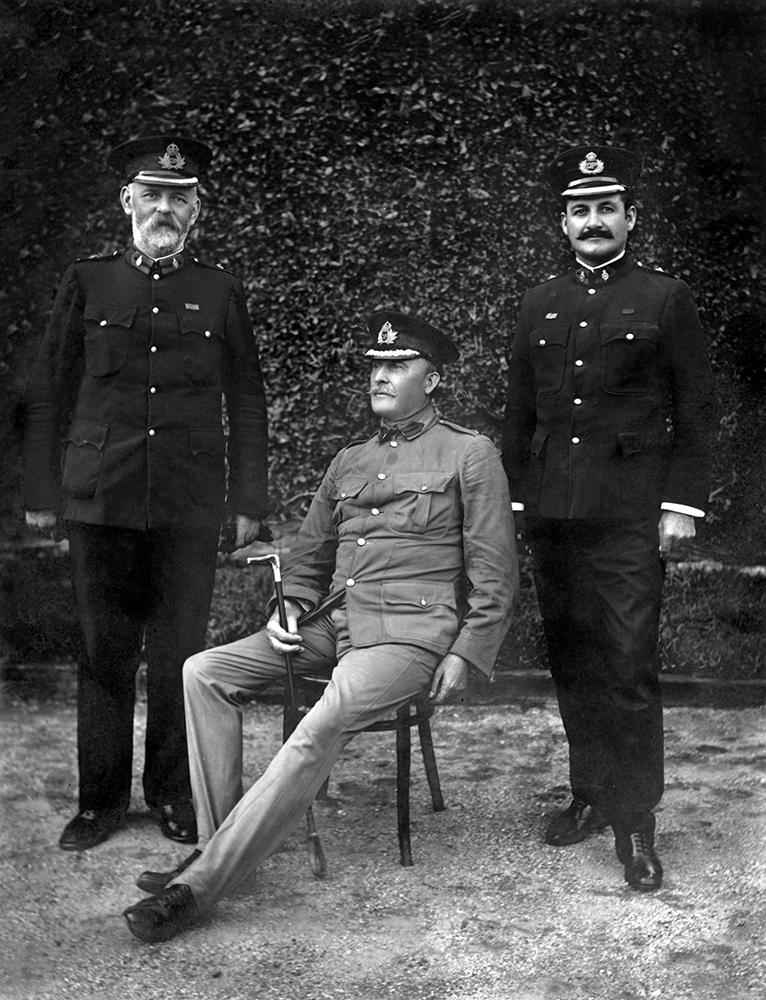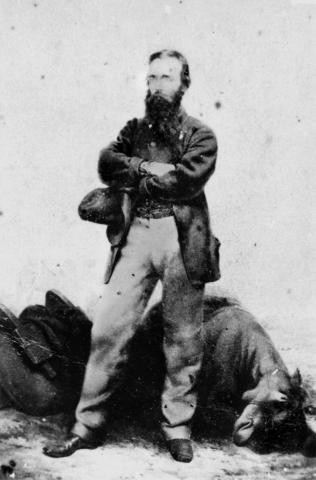
- Biography of Frederic Charles Urquhart
-
The following information is published courtesy of the Queensland Police Museum.
Frederic Charles Urquhart (1858-1921), a Midshipman, Line Repairer, Police Commissioner and Administrator, was born on 27th October, 1858 at St. Leonard’s-on-Sea, Sussex, England, son of Frederic Day Urquhart, a Major with the Bengal Army and his wife Charlotte, nee Goldie. Urquhart was educated at the All Saints School in Bloxham, Oxfordshire, and Felsted Military School, Essex. Before Urquhart migrated to Queensland in 1875 to join his godfather, General Fielding, he was a midshipman on a sailing vessel called the ‘Essex’ which sailed between England and Australia. When he arrived in Queensland he first worked in the cattle and sugar industries for three years, before becoming a Telegraph Line Repairer with the Electric Telegraph Department in 1878 at Normanton. When Urquhart was faced with an automatic promotion in a clerical capacity he resigned and joined the police force.
Urquhart joined the Queensland Native Mounted Police Force on 27th April, 1882 as a Cadet Sub-Inspector and was put in charge of the Native Mounted Police. During his seven years with the Native Mounted Police, Urquhart was wounded twice, having been speared in the groin and in the thigh by a tomahawk and had to travel 270 kilometres to receive medical treatment. He eventually transferred to the general police in 1889. During his time with the Queensland Police he was stationed in several places which included Carl Creek, Dunrobin, Cloncurry, Coreela, Maytown, Thursday Island and Brisbane and found himself involved in some interesting events.
In 1890, Urquhart was the first on scene to search for survivors and the bodies from the wreck R.M.S.S. Quetta, a Royal Mail Steamer, en route from Australia to England. In 1901, during the visit of His Gracious Majesty the King, Urquhart was put in charge of the Royal trains and Government House. When Urquhart was promoted to Second Class Inspector in 1898, Urquhart was in charge of the Criminal Investigation Branch and was eventually at the centre of a controversy in 1899 involving the handling of the investigation into the famous Gatton triple murders. However, Urquhart survived the enquiry and was eventually promoted to Chief Inspector in 1905.
Urquhart was Chief Inspector during Brisbane’s most tumultuous times, when in 1912 Brisbane came to a standstill which was the result of unionists from the Brisbane Tramways Company going on strike. Urquhart and the then Commissioner Cahill were part of the 3000 police in force during the illegal march attended by thousands in Market Street, which finally collapsed and the strike ending due to the police’s baton charge. He then went on to become our fourth Commissioner in 1917 on January 1st and was the first to rise to a commissioned rank from an officer to the top position.
Apart from being the Commissioner of the Queensland Police, Urquhart was an accomplished writer of poetry that were published as books and some of his works were ‘Camp Canzonettes’, ‘An Ocean Ghost’ and ‘Legends of the Blacks’. He was also noted for being an early explorer of Queensland having charted Albatross Bay, Emberley and Hay Rivers in Far North Queensland.
Urquhart retired from the Police Force in 1921 and was appointed as an Administrator of Northern Territory by the Commonwealth Government and he held this position until 1925. He eventually settled in Clayfield, Brisbane and he died on 2nd December, 1935 at St. Helen’s Private Hospital, aged 77 and is buried at the Toowong Cemetery.
- Biography William Geoffrey Cahill
-
William Geoffrey Cahill (1854-1931), public servant and police commissioner, was born on 7 November 1854 at Strokestown, Roscommon, Ireland, son of John Cahill, of Ennis, and his wife. Educated at the Strokestown National School, he served in the Royal Irish Constabulary, then migrated to Australia with his wife Lavinia, née Bernie. They arrived at Maryborough, Queensland, in the Highflyer on 2 December 1878.
Cahill joined the Queensland Public Service on 1 August 1879 as second clerk in the registry of the Supreme Court in Brisbane. He became first clerk during 1880, deputy curator of intestate estates from 1 January 1885, registrar of the Southern District Court on 1 June 1887, and secretary to the crown law officers on 19 March 1889; the position was retitled under-secretary for justice on 14 May 1890. On 1 April 1905 he was appointed commissioner of police, and on 7 September protector of Aborigines. Following the Police Act Amendment Act of 1912, which limited the commissioner's term to five years, he was reappointed on 19 December until 1917.
Cahill served in the militia, being promoted lieutenant from sergeant in the Brisbane Volunteer Rifle Corps (Queensland Volunteer Rifles) in 1885, captain in 1887 and major in 1891. He relieved Lieutenant-Colonel Andrew Thynne as commander of the volunteer infantry in the southern military district while Thynne was overseas in 1894-95. Transferred to the unattached officers list on 18 June 1896, Cahill resigned his commission on 6 April 1897 (probably in protest at the appointment of a non-volunteer commanding officer), but was reappointed major on 9 December. He resigned in 1905 when appointed commissioner of police.
Cahill was a capable administrator in the justice department, supervising a period of expansion and introducing reforms to the Queensland police force, including free uniforms and better pensions. He made every effort to have police relieved of extraneous government duties in rural areas—without notable success. He pressed for better arms and ammunition, and set up a police horse-breeding establishment at Woodford which was moved later to Rewan, south of Springsure. 'Somewhat inclined to be a martinet', he tightened discipline, following the practice of the Royal Irish Constabulary, and in 1913 issued a Policeman's Manual, adapted from the Irish version for Queensland conditions. He tried to improve training conditions and to modernize the criminal investigation branch. His responsibilities as commissioner included increasing control of urban traffic, closer supervision of liquor licensing and gambling, and enforcement of infant life protection legislation.
The Brisbane general strike of 1912 was the critical point of Cahill's career. Charged with preservation of law and order by the D. F. Denham government, he had to resist the demands for rigorous suppression made by extreme anti-unionists, maintain control of the irregular force of special constables sworn in to assist the regular force, and deal with a potentially serious civil disturbance. After days of increasing tension and some street incidents, the strike leaders ignored his instruction not to assemble on Friday, 2 February. Confronting the demonstrators in Albert Street, Cahill led a baton charge to disperse the crowd and was thrown from his horse in the mêlée. The police prevailed without serious injury to either side and incidents thereafter gradually decreased. Cahill was threatened that a future Labor administration would give him four minutes to resign, but he was complimented by the government and its supporters.
On the election of the T. J. Ryan Labor ministry in 1915, Cahill retained office, with his erstwhile opponent David Bowman, one of the 1912 strike leaders, as his ministerial head. After quarrelling with senior officers of the Home Secretary's Office on police policy and control, he clashed with John Huxham, who succeeded Bowman as home secretary on 23 March 1916, over the formation of a police union which, to Cahill, constituted a breach of good order and discipline. In December he applied for and was granted early retirement on medical grounds, with a pension of £450 a year.
Cahill was described as 'outwardly stern' and 'reserved', but 'tall, lithe, well set up and strikingly handsome'. He was awarded the Volunteer Officers' Decoration in 1911 and was appointed C.M.G. in December 1912. He was honorary aide-de-camp to two governors in 1912-16. Predeceased by his wife and childless, Cahill died of cirrhosis of the liver at his home at Newmarket, Brisbane, on 25 April 1931; he was buried in the Catholic section of Nudgee cemetery.



